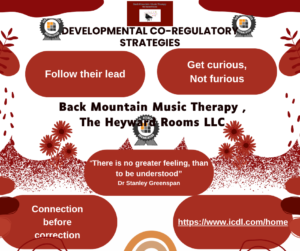
What is the difference between self regulation and compliance? A LOT! If your child is in therapy and this word is a goal, BEWARE! Compliance has to do with the needs of the person in charge. “Self-Regulation” has to do with the individual’s ability to calm themselves and be attentive. This is accomplished through “Co-regulation“. So as you read ICDL’s (http://www.icdl.com/) yellow post, are you asking yourself “Yes, but what’s wrong with what I am doing when I give them a privledge or reward for sitting down? Aren’t I helping them ?” Here is the difference:

(https://www.facebook.com/photo?fbid=1122661779909980&set=a.612807634228733 ) If you are giving the individul a reward, or a consequence for doing something YOU need them to do, in order to proceed, you are not co-regulating with that individual. If, on the other hand, you are ATTUNING to that individual and are sensing that they are feeling overwhelmed (understimulated), scared, unsure , stuck (bored or not challenged enough) and you are doing things such as lowering (or bringing up) the volume, decreasing (or increasing) the amount of stimulation or affect in the enviornment, lowering (or bringing up ) the challenge, depending on the individual , in order to bring them back to a balance so that THEY CAN CALM DOWN AND ATTEND with ease, then you are probably acting as a co-regulator.
A good co-regulator observeservedly attunes to the other and gives support, and matches the needs of the other. This is immenently important when working with fight/flight/freeze states, in both children and adults. One doesnt have to be a health professional to be in situations where this is needed. This matters in many types of relationships. Teacher/student, romantic partnerships, familial relationships, organizational relationships, etc. The reward for the individual is in the change of process and the relationship. Their change in behavior is driven from what is already within the client. That change, That relating is the reward. It feels good to be seen and heard!
Often, we see others wanting to increase or decrease certain behaviors. What if we, instead, look at why are those things happening in the first place? We can help when we are providing a relationship with warmth and safety. We can help when we are listening to the cues of another, what are they telling us by the tone of their voice, the affect in their face, gestures and their posture?
Are we a co-regulator or a dysregulator enhancer, attempting to co-erce compliance?
Antoinette Morrison


Leave a Reply